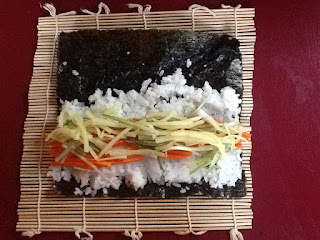1 c. rice (See Rice in the Glossary) Sushi rice, being sticky, does an
excellent job of holding a sushi roll together, but other rice can be
substituted.
1 tsp. salt (See Salt in the Glossary)
2 Tb. sugar (See Sugar in the Glossary)
3 Tb. white vinegar (See Vinegar in the Glossary) or 2 Tb. freshly
1 tsp. salt (See Salt in the Glossary)
2 Tb. sugar (See Sugar in the Glossary)
3 Tb. white vinegar (See Vinegar in the Glossary) or 2 Tb. freshly
squeezed lime juice (See Juice in the Glossary)
(totally optional) 1/4 c. sesame seeds—1 Tb. sesame seeds per sushi roll
(totally optional) 1/4 c. sesame seeds—1 Tb. sesame seeds per sushi roll
containing sesame seeds
4 sheets of nori (some nori has sesame seed oil on it: read the label)
2 or 3 filling ingredients (your choice of raw fish—ask your grocer which fish are ok for sushi, slivered green onions, slivered raw carrot, cucumber strips [See Produce in the Glossary], corn-free, yeast-free marinated daikon, slightly cooked spinach or whatever else you feel like using and aren't allergic to)
Cook the rice according to the directions on the package. Stir in the salt, sugar and vinegar or lime juice. Put the sesame seeds in a small pan over high heat and toast them, stirring constantly. As soon as the seeds are lightly browned, pour them out into a bowl so that the hot saucepan does not continue to cook them. Arrange your ingredients and a bamboo sushi rolling thing in front of you and you are ready to assemble the sushi rolls.
Use a wooden paddle (or the back of a big spoon) to spread ¼ of the rice onto the less shiny side of a sheet of nori, leaving one end of the nori uncovered.
Sprinkle 1/4 of the sesame seeds on top of the rice. If you need some of the rolls to be sesame-free, make those first, before there are stray seeds lying about your work area.
Arrange the filling ingredients in a line on top of the rice. Roll up using a bamboo rolling thing such that the uncovered end of the nori is on the top and can stick to the layer of nori below it, sealing the roll.
Slice with a sharp knife and serve with wasabi and/or Sushi Dipping Sauce.
4 sheets of nori (some nori has sesame seed oil on it: read the label)
2 or 3 filling ingredients (your choice of raw fish—ask your grocer which fish are ok for sushi, slivered green onions, slivered raw carrot, cucumber strips [See Produce in the Glossary], corn-free, yeast-free marinated daikon, slightly cooked spinach or whatever else you feel like using and aren't allergic to)
Cook the rice according to the directions on the package. Stir in the salt, sugar and vinegar or lime juice. Put the sesame seeds in a small pan over high heat and toast them, stirring constantly. As soon as the seeds are lightly browned, pour them out into a bowl so that the hot saucepan does not continue to cook them. Arrange your ingredients and a bamboo sushi rolling thing in front of you and you are ready to assemble the sushi rolls.
 |
| Getting ready to make sushi with slivered green onion, daikon pickle and carrot |
Use a wooden paddle (or the back of a big spoon) to spread ¼ of the rice onto the less shiny side of a sheet of nori, leaving one end of the nori uncovered.
Sprinkle 1/4 of the sesame seeds on top of the rice. If you need some of the rolls to be sesame-free, make those first, before there are stray seeds lying about your work area.
Arrange the filling ingredients in a line on top of the rice. Roll up using a bamboo rolling thing such that the uncovered end of the nori is on the top and can stick to the layer of nori below it, sealing the roll.
 |
| Ready to roll |
Slice with a sharp knife and serve with wasabi and/or Sushi Dipping Sauce.



